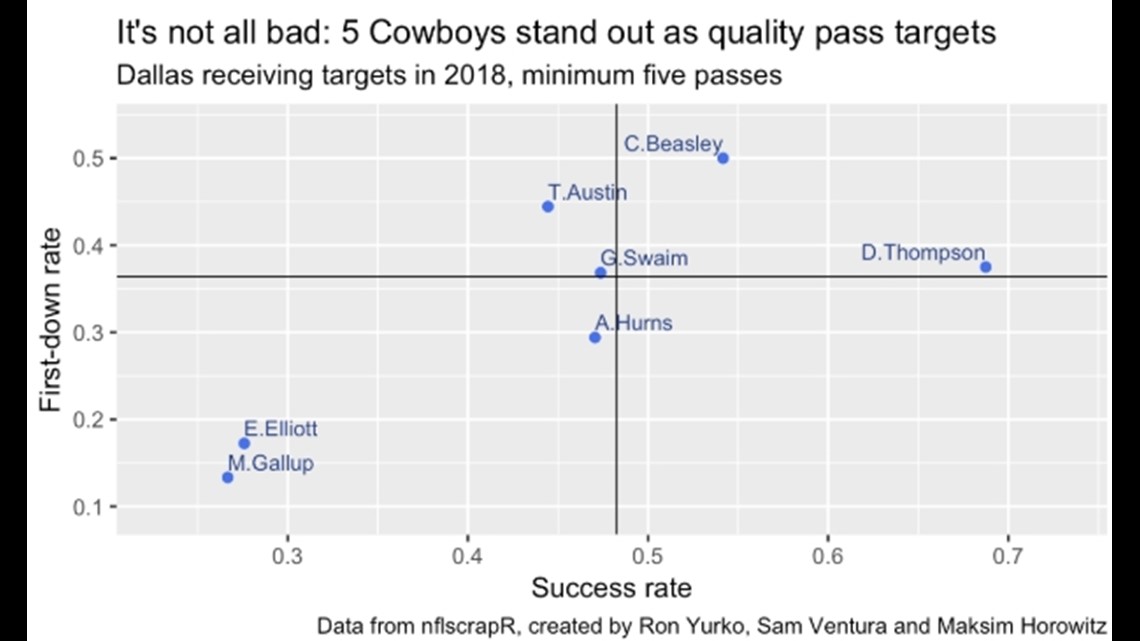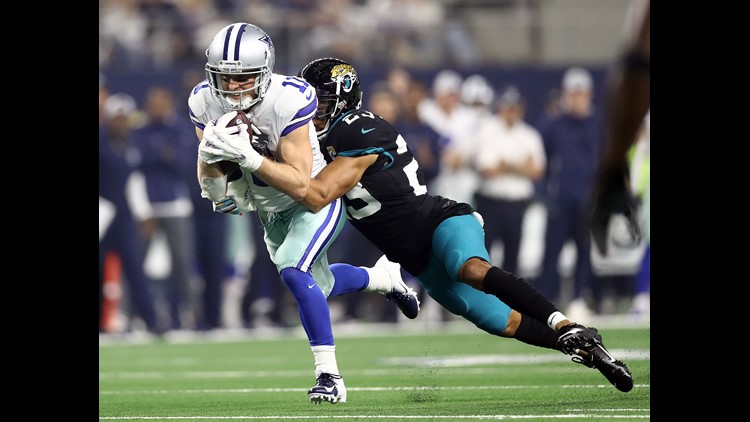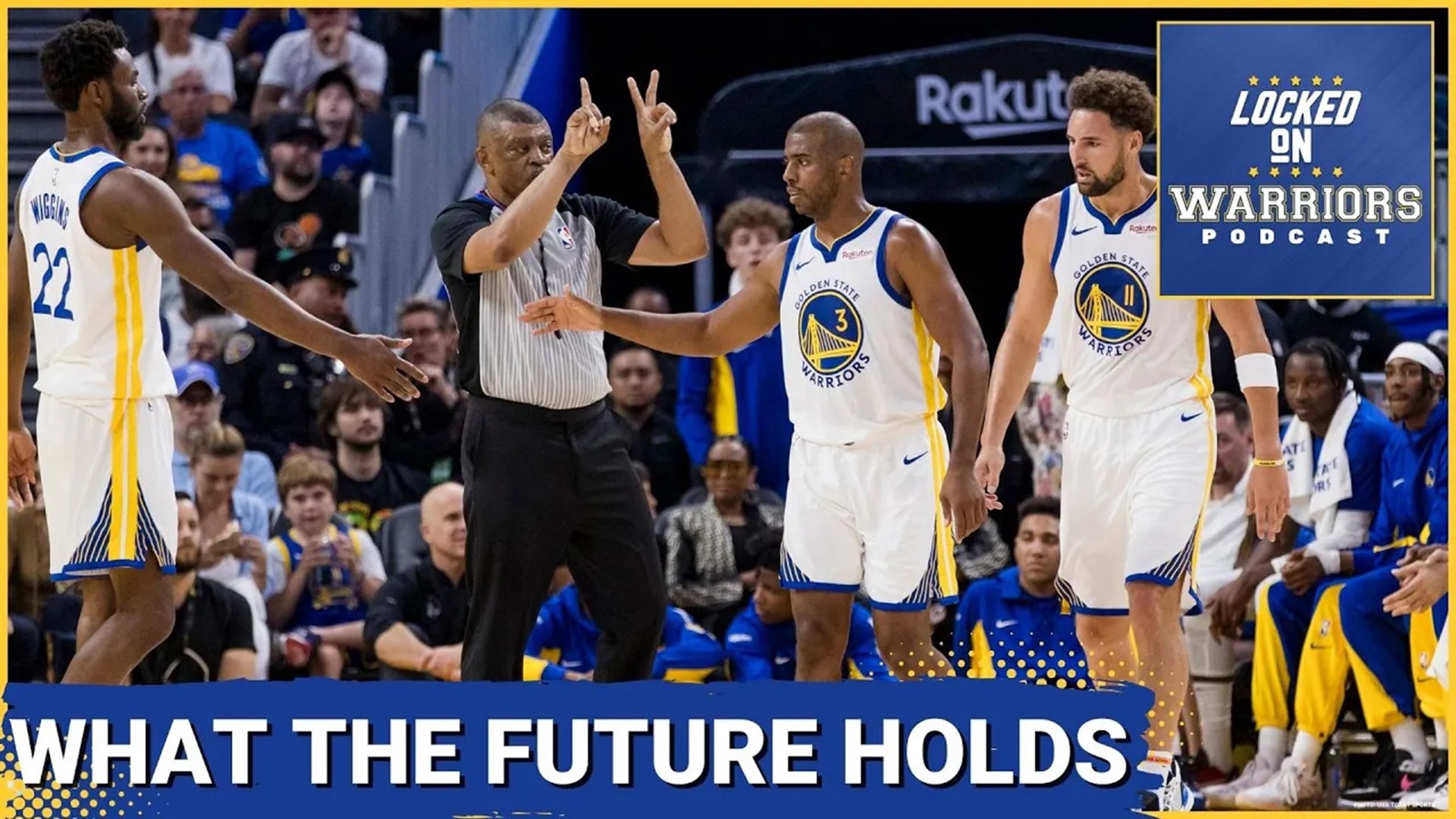DALLAS — The Cowboys offensive onslaught from Sunday’s 40-7 win, both blistering in its efficiency and brutal in its finality, appeared to come from nowhere.
The passing game’s failures in the first five weeks of the season weighed heavily on the minds of the fanbase, with the team struggling for weeks to put together quality possessions as drive after drive ended on failed third-down plays.
Then on Sunday, Cowboys quarterback Dak Prescott ran at will and picked apart the Jacksonville Jaguars through the air, finding Cole Beasley as the shifty slot receiver cut through one of the league’s best secondaries like a hot knife through butter.
The thing is, this success shouldn't have been a surprise. Well, no one could have predicted just how successful the Cowboys offense would be on Sunday, especially against this particular opponent. But I believe the signs have been there all season. The formula we saw on Sunday was how this team was designed to win.
It’s important to recognize how difficult it can be to identify what’s going well when a team is losing. Our eyes—and traditional stats like yardage totals—don’t always paint an accurate picture. We remember certain plays more than others that might be more revealing, and the narratives we latch onto while watching the game are often informed more by our prior assumptions than what’s happening on the field.
But thanks to one of the most comprehensive play-by-play databases available to the public, we can see exactly where the Cowboys offense was breaking down before the Jaguars game—and come up with a blueprint for tailoring an effective passing game to the current personnel.
For this analysis, I used a play-by-play database and expected-points model created by Ron Yurko, Sam Ventura and Maksim Horowitz.
I began this analysis before the Jaguars game, expecting to find a lot of dysfunction throughout the offense. But the conclusion I came to after reviewing the most comprehensive data available is that the Cowboys passing game was a lot closer to being good than it first appeared.
Reliable receivers had already emerged
My most surprising finding from the first five weeks of play—when the Cowboys fell to a 2-3 record—was that a significant portion of the Cowboys passing game had actually been quite successful.
That success had, unfortunately, been obscured by an unusual number of failed third downs and sacks, as well as suboptimal pass distribution—issues that the Cowboys had to address immediately if they wanted to have a shot at salvaging a chance at the playoffs this season.
Even before the Jaguars game, when Dak Prescott threw to his five best receivers—namely, Cole Beasley, Geoff Swaim, Allen Hurns, Deonte Thompson and Tavon Austin—the team was pretty good at moving the chains and improving their odds of scoring.
The key problem was that the Cowboys leading pass target was none of those guys. Instead, Prescott threw to his running back Ezekiel Elliott more often than any one of his wideouts or tight ends, and the results (aside from his two huge receptions against Detroit) were sinking drives.
On top of this, Prescott’s connection with rookie wideout Michael Gallup had been similarly damaging, to the point that I thought the team should consider scaling back his role in the offense for a while. (After an impressive first quarter from the rookie on Sunday, I’d hold off on that idea for now.)
One of the difficult things about analyzing small samples of data is that one or two relatively rare events—such as an explosive play, or a game-changing interception—can color our view of what’s working in a way that doesn’t give us a good idea of what the offense can look like going forward.
To avoid falling into this trap as best I could, I tried to look at the receiving corps from two specific perspectives: the percentage of passes to each receiver that result in first downs, and the percentage of plays that successfully improved the team’s expected scoring margin. Both of these stats are powerful tools for explaining offensive success, and fairly consistent over time.
Keeping in mind that I made this chart using numbers from before the Jaguars game, here’s what I found:


The vertical and horizontal lines above represented league-average rates on all non-sack pass plays. You’ll notice that Prescott could already rely on five Cowboys receiving targets to move the chains and improve the team’s expected scoring margin at a near- or above-average clip.
Then, far down to the left, you see Elliott and Gallup, who had taken up a significant share of the team’s pass targets.
What’s working—and what’s not
With that in mind, I broke down the pre-Jaguars-game offense into a few simple categories to see how each component was actually affecting the scoring margin, according to EPA.
If you aren't familiar with expected-points models, the simple explanation is that every play has a historical point value based primarily on down, distance and field position. If the expected point value after the play is 1 point higher than it was beforehand, then the “expected points added” on the play, or EPA, is +1.00.
In the table below, notice how much success the Cowboys were having when Prescott threw to his best five receiving targets, as outlined above. Then look at how much the offense suffered throwing to everyone else—primarily Elliott and Gallup. Remember, all numbers are from before Sunday’s game, when the narrative was that the offense was in total disarray.
The takeaways: The Cowboys running game was already great, their quarterback could move the chains in multiple ways, and their best group of receiving targets had only been thrown to 60 percent of the time. Former quarterback Tony Romo, for reference, threw to Jason Witten or his three starting wideouts on 72 percent of passes in his career-best 2014 season.
It was obvious coming into this Jaguars game that the team could have more success by finding a way to increase the share of passes going to his best targets—and, importantly, cut down on the types of throws that just weren't working.
“What you really have to do as a quarterback, if you find that a player can’t do something, I stop going to that guy in that situation,” Romo said a few weeks back on a CBS panel when asked to diagnose the Cowboys offensive woes. “He’s shown me that this isn’t allowed, fine. I start moving through, going to the next guy.
“And what I’m going to find is the guy that I can consistently count on to really either be in the spot, or to catch a tough, contested catch, and just keep doing that over and over.”
For the Cowboys, that guy so far is Beasley, who, in a manner reminiscent of his 2016 season, just can’t stop getting open and picking up first downs. The team’s No. 1 pass target on Sunday was just continuing what he was doing in the previous five games. The difference was, the Jaguars defense defended him too boldly, and the Cowboys put themselves in position to take advantage.
The Cowboys also leaned into another critical advantage that has been there for them all season: designed quarterback runs. Coming into the Jaguars game, Prescott had 11 designed rushes for five first downs and a two-point conversion. He added to that on Sunday a 17-yard rushing touchdown on 2nd-and-10, and three chain-moving scrambles.
The two greatest strengths of this Cowboys' offense on passing downs have been the chain-moving efficiency of its slot receiver and its quarterback’s rushing ability—the very traits the team leaned on even further to tear apart the Jaguars. Prescott also did a good job distributing the ball to his wide receivers, without relying on his running back’s shorter routes as a fallback.
There are many reasons to be excited about Sunday’s win. The one that sticks with me, though, is how replicable the formula appears to be.
Do you think the wideouts are holding up their end of the bargain or does Dak need more weapons? Daniel has more statistical analysis available @CowboysStats.



